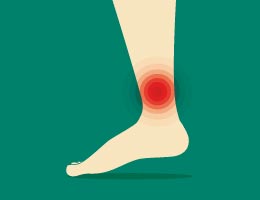
A simple test on your ankle could give you a heads-up on heart disease. It's called an ankle-brachial index (ABI). And it's used to detect signs of poor blood flow in your legs.
That diminished blood flow can be a sign of peripheral artery disease (PAD), a serious condition linked to heart disease and stroke.
What is PAD?
PAD is a narrowing of the arteries that feed the legs, stomach, arms and head. Most often, it affects arteries in the legs.
The disease occurs when plaque builds up inside artery walls. If enough builds up, it can narrow an artery and choke off blood flow.
When PAD develops in the lower extremities, its most common symptom is a painful cramping in the hips, thighs or calves. It occurs when you walk, climb stairs or exercise. But it goes away in a few minutes when you rest.
This cramping is a warning that your muscles aren't getting enough blood to meet the extra demand of being active. Other symptoms include:
- Leg pain that doesn't go away when you stop exercising.
- Foot or toe wounds that won't heal or that go away very slowly.
- A marked decrease in the temperature of the lower leg or foot.
- Poor toenail growth or poor hair growth on the legs.
Why screening matters
Many people with PAD may have no symptoms or mistake their leg pain for something else, such as arthritis or a normal part of aging.
But people with PAD in the legs often have the same buildup of plaque in other arteries, including those in the heart and brain. That raises the risk of both heart attack and stroke.
Left untreated, PAD can also cause gangrene and lead to an amputation.
So never shrug off any recurring leg pain—always tell your doctor about it. And even if you're not having any PAD symptoms, the National Institutes of Health advises asking your doctor if you should be checked for PAD if you have risk factors.
The ABI test can help determine if you have PAD. It's painless, takes only a few minutes and can be done by your doctor as part of a routine exam.
During it, a doctor compares the blood pressure in your ankles to the blood pressure in your arms. Normally, the ankle pressure is at least 90% of the arm pressure. But with severe narrowing, it may be less than 40%.
If the results seem abnormal, your doctor may advise other tests to confirm a possible diagnosis.
Living with PAD
If you do have PAD, treatment can help you manage it—or even reverse it. Overall, treatment goals include not only controlling any symptoms, but also keeping you safe from a heart attack or stroke.
Often, the first step is making lifelong, healthy lifestyle changes, such as moving more, sticking to a heart-friendly diet and stopping smoking if you light up. If you feel pain when walking, a supervised exercise program may be especially beneficial.
Medicine may also be necessary for some people. And if an artery is severely blocked, it may need to be opened with angioplasty or even surgery.
In short, there's help—and plenty of it—for PAD. Start by seeing your doctor if you have symptoms or are at risk for the disease.
Reviewed 11/27/2024